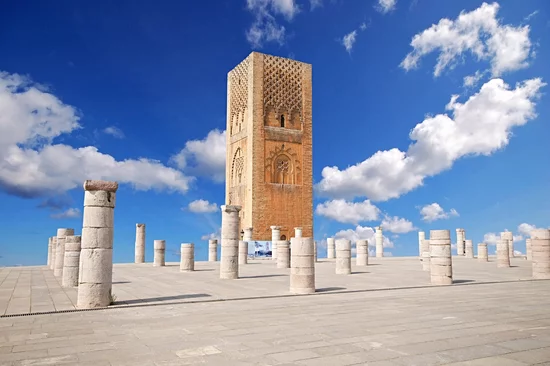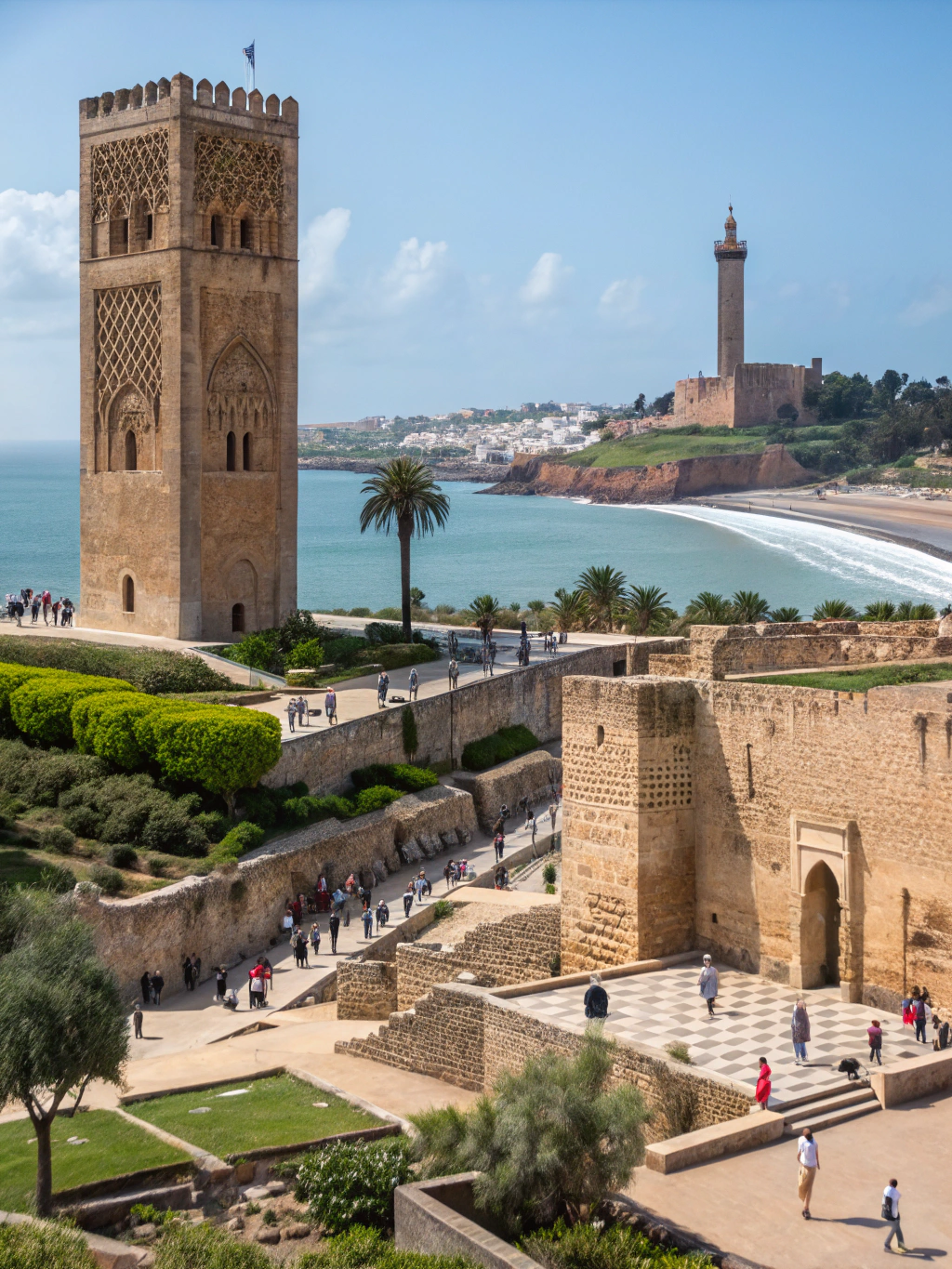Introduction
Is Morocco’s capital merely a political administrative center, or does Rabat harbor centuries of imperial heritage waiting to captivate curious travelers? Recent tourism data reveals that while Marrakech attracts 2.5 million visitors annually, Rabat welcomes just 800,000—yet UNESCO designated the entire city a World Heritage Site in 2012. This striking disparity highlights one of Morocco’s best-kept secrets. From the majestic Hassan Tower piercing the Atlantic skyline to the azure-washed walls of the Oudayas Kasbah, there are countless remarkable things to do in Rabat that rival any imperial city. Morocco’s sophisticated capital seamlessly blends Almohad architecture, French colonial boulevards, and contemporary Moroccan culture into an unforgettable urban tapestry.
- Introduction
- Essentials & Must-Dos
- Timing & Scheduling
- Step-by-Step Itinerary
- Day 1: Imperial Grandeur and Modern Morocco
- Day 2: Medina Magic and Coastal Views
- Day 3: Archaeological Wonders and Cultural Immersion
- Health & Safety Advisories
- Alternative Routes & Experiences
- Suggested Activities & Pairings
- Common Mistakes to Avoid
- Logistics & Storing Tips
- Conclusion
- FAQs
Essentials & Must-Dos

Before exploring Rabat’s treasures, pack comfortable walking shoes for navigating cobblestone medina streets and marble mausoleum floors. Bring a wide-brimmed hat and sunscreen—the Atlantic breeze can be deceptive while the Moroccan sun remains intense. Download offline maps as Wi-Fi can be spotty in historical quarters, though most cafés offer reliable internet. Pack modest clothing covering shoulders and knees for mosque visits and traditional neighborhoods. A portable phone charger proves invaluable for capturing Instagram-worthy shots of the blue-and-white Andalusian gardens. Instead of guidebooks, consider downloading cultural audio tours that provide rich historical context while leaving your hands free for photography. Carry small bills (20-50 dirham notes) for local vendors, taxis, and café tips. A reusable water bottle helps you stay hydrated while exploring expansive archaeological sites like Chellah’s sprawling ruins.
Timing & Scheduling
Optimal planning begins 2-3 weeks before departure, allowing time for accommodation research and potential visa requirements (most visitors receive 90-day stamps upon arrival). Rabat shines brightest during spring (March-May) and autumn (September-November) when temperatures hover between 20-25°C and rainfall remains minimal. Summer visits can be rewarding but expect 30-35°C temperatures, while winter brings occasional rain and cooler 15-20°C days. Weekend visits (Friday-Sunday) offer vibrant local energy but expect larger crowds at popular sites. According to Morocco’s tourism board, visiting during Ramadan provides unique cultural insights, though restaurant hours change significantly. Book accommodations early during international festivals or when the royal court is in residence, as hotel availability drops dramatically. Budget travelers can save 30-40% on accommodations by visiting during January-February, though weather can be unpredictable.
Step-by-Step Itinerary
Day 1: Imperial Grandeur and Modern Morocco
Start your Rabat adventure at the iconic Hassan Tower, where 12th-century Almohad ambitions created one of the world’s most photographed incomplete minarets. Arrive at 9 AM to capture golden morning light illuminating the 44-meter sandstone tower. Spend 90 minutes exploring the adjacent Mausoleum of Mohammed V, where intricate zellige tilework and carved cedar demonstrate Moroccan craftsmanship at its finest. Walk 15 minutes to Avenue Mohammed V for a coffee break at Café Maure, where locals gather for traditional mint tea and pastries.
Dedicate your afternoon to the Royal Palace district, admiring the ornate gates and pristine gardens (photography from outside only). Continue to the modern Agdal neighborhood for lunch at contemporary restaurants serving fusion Moroccan cuisine. End your day at the Hassan II Stadium area, where evening joggers and families create a vibrant local atmosphere.
Day 2: Medina Magic and Coastal Views
Begin at 8:30 AM in the Oudayas Kasbah, Rabat’s most enchanting quarter where blue-and-white Andalusian architecture transports visitors to southern Spain. Navigate narrow alleyways leading to breathtaking Atlantic Ocean viewpoints. The Oudayas Museum provides fascinating insights into Moroccan decorative arts and costs just 20 dirhams. Don’t miss the Andalusian Gardens, where orange trees and fountain courtyards offer peaceful respite.
Explore Rabat’s medina after lunch, where authentic souks sell traditional crafts without aggressive tourism pressure found in larger cities. The carpet cooperative near Rue Souika demonstrates traditional weaving techniques. Conclude with sunset drinks at Villa Mandarine’s terrace, overlooking the Bouregreg River where traditional boats create picturesque silhouettes.
Day 3: Archaeological Wonders and Cultural Immersion
Dedicate your final day to Chellah, an extraordinary archaeological site where Roman ruins blend with Islamic monuments in a garden setting populated by nesting storks. This 20-dirham entrance fee provides access to 2,000 years of continuous human settlement. Spend 2-3 hours wandering ancient streets, Islamic schools, and royal tombs.
Visit the National Archaeological Museum for context about Morocco’s pre-Islamic civilizations. The Mohammed VI Museum of Modern and Contemporary Art showcases cutting-edge Moroccan artistic expression. End your journey at Bouregreg Marina, where waterfront restaurants serve fresh seafood while traditional fishing boats bob in the harbor.
Health & Safety Advisories
rabat morocco attractions, is rabat worth visiting, capital of morocco, rabat day trip, hassan tower, oudayas kasbah are generally safe for international travelers. The US State Department maintains a Level 2 advisory for Morocco, indicating normal safety precautions. No special vaccinations are required, though ensuring routine immunizations remain current is advisable. Rabat’s tap water meets WHO standards, but bottled water prevents potential stomach sensitivity.
Women travelers report feeling comfortable in Rabat’s cosmopolitan environment, though modest dress remains respectful. Petty theft occurs occasionally in crowded areas—secure valuables and avoid displaying expensive electronics. The tourist police (Brigade Touristique) patrol major attractions and speak multiple languages. Emergency numbers include Police (19) and Medical Emergency (15). Travel insurance covering medical evacuation provides peace of mind for adventure activities.
Alternative Routes & Experiences
Budget-Conscious Travelers: Stay in medina riads (€25-40/night) and eat at local restaurants serving tagines for under €5. Public buses connect major sites for less than €1, while the new tramway offers modern, air-conditioned transport. Free activities include beach walks, medina exploration, and viewing architectural exteriors.
Luxury Seekers: Book oceanfront suites at La Tour Hassan Palace or Villa Mandarine. Private guided tours with certified experts cost €150-200/day and include exclusive access to artisan workshops. Helicopter tours over the Atlantic coastline and private cooking classes with royal palace chefs create unforgettable experiences.
Family Travelers: The Rabat Zoo houses Barbary lions in naturalistic habitats, while Temara Beach offers safe swimming with lifeguard supervision. Interactive workshops at the National Library teach Arabic calligraphy, and horse-drawn carriage tours delight children while covering major sites efficiently.
Suggested Activities & Pairings
Enhance your Rabat experience by pairing historical exploration with contemporary cultural immersion. Combine morning visits to ancient sites with afternoon cooking classes learning to prepare authentic pastilla or couscous. Art enthusiasts should coordinate museum visits with gallery openings in the Agdal district, where young Moroccan artists showcase innovative works.
Consider day trips to nearby Salé, where traditional pottery workshops demonstrate techniques unchanged for centuries. The coastal road to Temara offers excellent surfing opportunities paired with fresh seafood lunches. Photography workshops focusing on Islamic architecture complement historical site visits, while Arabic language exchange sessions with university students provide authentic cultural connections.
Evening activities include traditional music performances at Institut Français and rooftop dining experiences overlooking illuminated monuments. Wellness travelers can combine sightseeing with hammam experiences and traditional massage treatments using argan oil.
Common Mistakes to Avoid
Common Mistake: Assuming Rabat lacks excitement compared to Marrakech or Fez. Reality: Rabat offers sophisticated experiences without overwhelming tourist crowds, making it ideal for authentic Moroccan encounters.
Currency Error: Expecting to pay with euros or dollars everywhere. Solution: Exchange money at banks or official bureaux de change for better rates than hotels or airports.
Timing Mistake: Visiting major sites during Friday prayers (12-2 PM) when many attractions close temporarily. Plan museum visits or shopping during prayer times instead.
Transportation Error: Relying solely on petit taxis for longer distances. The modern tramway connects major areas efficiently and costs significantly less than repeated taxi rides.
Photography Mistake: Photographing people without permission or taking pictures of government buildings. Always ask consent and avoid sensitive areas near the Royal Palace or military installations.
Logistics & Storing Tips
Store digital copies of your passport, travel insurance, and hotel confirmations in cloud storage accessible offline. Download translation apps with Arabic phrases, though French and English are widely spoken in tourist areas. Keep emergency cash in multiple locations and notify banks of your travel dates to prevent card blocking.
Organize day packs with separate compartments for valuables, snacks, and cultural site entry fees. A small shoulder bag works better than backpacks in crowded medina areas. Store leather goods away from humidity and dust—Rabat’s Atlantic location creates moisture that can damage purchases.
For longer stays, weekly apartment rentals in Agdal or Hassan neighborhoods provide local experiences with modern amenities. Laundry services operate throughout the city, typically completing same-day service for reasonable fees.
Conclusion
Rabat demonstrates that Morocco’s most rewarding destinations often hide in plain sight. From the architectural grandeur of Hassan Tower to the intimate blue-washed alleyways of Oudayas Kasbah, Morocco’s capital offers sophisticated travelers an authentic North African experience without overwhelming crowds. Whether you’re drawn by centuries of imperial history, contemporary Moroccan culture, or simply seeking Instagram-worthy Atlantic coastline views, Rabat delivers memorable experiences that showcase Morocco’s evolution from ancient kingdoms to modern African leadership.
Ready to discover why savvy travelers choose Rabat over more famous Moroccan destinations? Start planning your journey to Morocco’s most underrated imperial city, share your own Rabat discoveries in the comments below, or explore our comprehensive guides to other hidden Moroccan gems.
FAQs
How many days do you need in Rabat?
Two to three days provide adequate time for major attractions, though history enthusiasts could easily spend a week exploring museums, archaeological sites, and nearby coastal towns.
Is Rabat safe for solo female travelers?
Yes, Rabat is considered among Morocco’s safest cities for solo female travelers, with a cosmopolitan atmosphere and visible security presence in tourist areas.
What’s the best way to get from Casablanca airport to Rabat?
The new high-speed train (Al Boraq) connects Casablanca airport to Rabat in 45 minutes for approximately €7, offering the most convenient and economical option.
Can you visit Rabat as a day trip from Casablanca?
Absolutely. The one-hour train connection makes Rabat perfect for day trips, though overnight stays allow for deeper cultural immersion and sunset photography opportunities.
What makes Rabat different from other Moroccan imperial cities?
Rabat uniquely combines political significance with historical preservation, creating a more sophisticated, less touristy atmosphere while maintaining authentic Moroccan character and Atlantic coastal beauty.

